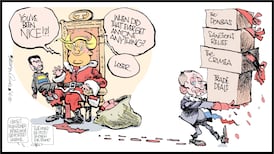There is a surreal moment in The Last Priests in Ireland when Arthur Mathews, who co-wrote Father Ted, reveals that he is related to Cardinal Paul Cullen, one of the most influential figures in Irish Catholicism.
Cullen was divisive in the 19th century and still is. One view on Cullen is represented in the documentary by former Catholic priest Dara Molloy, who now identifies as a Celtic priest, monk and druid.
Molloy believes that Cullen damaged Irish Catholicism by imposing rigid Roman customs on Celtic Christianity.
Others believe Cullen restored Irish Catholicism and made it a worldwide force, not least through exporting Irish priests and bishops across the globe.
READ MORE
Father Ted is also an Irish export and is loved worldwide. However, many Irish people believe that to fully understand the humour, you had to grow up in a pre-Celtic Tiger Ireland where having two uncles who were priests, as Mathews did, was not unusual.
When the actor who played Father Ted, Dermot Morgan, studied English and Philosophy at UCD in the early 1970s, he had many priest lecturers, including the future archbishop of Dublin Desmond Connell, a professor of philosophy. Fr Michael Paul Gallagher SJ was a much-loved English lecturer. Morgan had five concelebrants at his funeral mass.
Today, it is often quite hard to find one celebrant. Gallagher, one of those five priests, told the mourners that he had given the student Morgan a loan of a clerical collar so that Morgan could impersonate him at a lecture for first-year students. The actor told the students that the nursery rhyme Humpty Dumpty was an existentialist exploration of modern man, fallen from grace and searching for meaning in an absurd world.
The Last Priests in Ireland is presented by Ardal O’Hanlon, who played the gormless but essentially harmless Father Dougal in Father Ted. It also seems surreal that Channel Four was producing Father Ted, which is quite a gentle satirical comedy, at a time when questions about the extradition of Fr Brendan Smyth, sexual abuser of hundreds of children, led to the downfall of a government.
The revelation of sexual abuse of children by members of the clergy, and the initial denial and desperately inadequate responses, hastened the end of the Catholic Church’s influence. But secularisation was happening anyway.
The Irish have always been adaptable and pragmatic. From one of the most Catholic countries in Europe, we have moved seamlessly to being one of the most secular. Or have we?
Gladys Ganiel, in her 2016 book Transforming Post-Catholic Ireland, cites Jürgen Habermas’s definition of post-secular. He describes it “as a shift in consciousness in largely secularised or unchurched societies that by now have come to terms with the continued existence of religious communities, and with the influence of religious voices both in the national public sphere and on the global political stage”.
We may be heading for a time when post-secular is a more accurate description of Ireland than post-Catholic. Journalist Katie Hannon, in a post-screening discussion of the documentary on her TV programme Up Front, remarked on the calm nature of the debate.
Has Ireland moved on? There is still deep anger and a sense of betrayal, but in both O’Hanlon’s documentary and the one on women in religious life, The Last Nuns in Ireland, presented by Dearbhail McDonald, there was an emphasis on not losing sight of the positive contribution of priests and sisters.
McDonald’s was the livelier programme. We saw the toll that the scandals had taken on the sisters, who were left with the task of responding to the sexual abuse crises. We also saw the extraordinary, pioneering nature of women who ran schools and hospitals and brought education and advancement to women not just in Ireland but in the developing world.
Yet I don’t think that either documentary addressed a central issue. Vocations come mostly from families, although there are instances where people from non-religious families encounter and are drawn to the dedicated service of God as a celibate.
As long as families have no real commitment to faith or would be horrified if their child expressed an interest in religious life, vocations will always be in trouble.
The Church, despite much talk, has never really come to terms with the role of lay people. Often, it either tries to clericalise them or marginalise them. The church is essentially a very large voluntary organisation completely dependent on a number of committed members. A drop in priest numbers is a big problem but the lack of committed lay people on the ground is a not-unrelated and perhaps bigger problem.
Pope Benedict saw the solution as a smaller, purer Church, whereas Pope Francis’s approach might be summed up as “here comes everybody”, a gradualist approach where people at all levels of commitment are welcomed and encouraged to go deeper.
Both models need each other. A smaller Church can become inward-looking and even elitist. A church without a critical mass of highly committed people has no centre to which to invite anyone.
People can debate having marriage within the clergy but it is not anywhere nearly as important as having a strong community of married and single lay people who understand and aspire to the potentially radical and transformative nature of faith in Christ.













